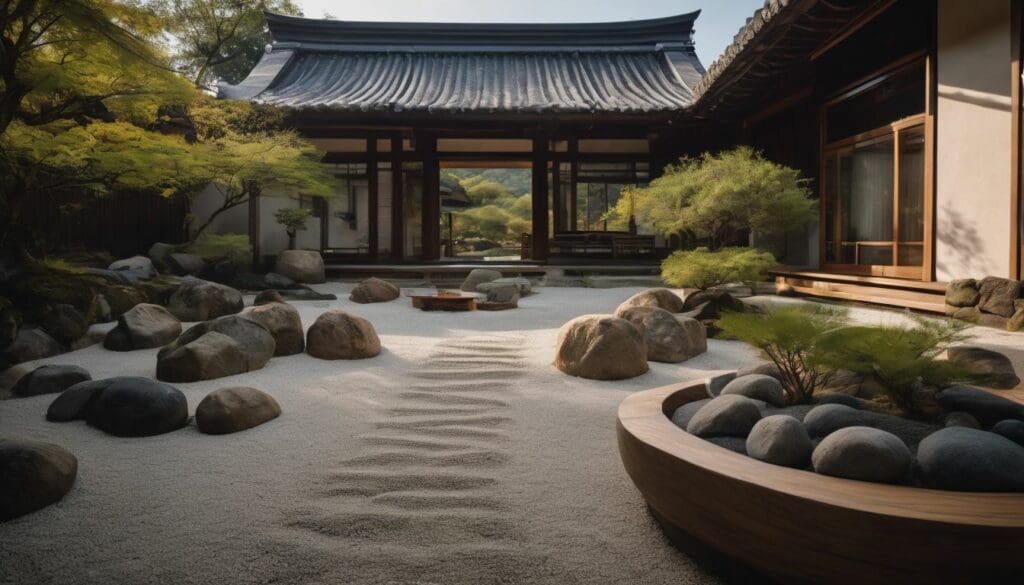We’re all rather familiar with the unrelenting pace of daily life, aren’t we? The ceaseless demands and cacophony that pervade our waking hours can indeed be taxing. Just like yourself, I’ve found myself grappling with the pressures that come hand-in-hand with such commotion.
However, you might take solace in knowing that a traditional Japanese Zen garden isn’t just a feast for the eyes; it’s scientifically backed to lower cortisol levels too. Our guide is lovingly crafted to help you carve out a tranquil haven amidst the hustle and bustle of your own back garden.
Together, let’s craft an enclave of tranquillity.
Key Takeaways
- A Zen garden comprises elements like gravel, rocks, and plants to promote peace and mindfulness.
- Key features such as raked sand, strategically placed stones, minimalistic plantings, and water features symbolise aspects of nature and spirituality.
- Regular maintenance activities like raking gravel, removing debris, weeding, and pruning are vital for preserving the tranquillity of your Zen space.
- Personal touches with specific plants like cherry trees or bonsai can enhance the serenity while promoting environmental conservation.
- Creating a designated area in the garden for relaxation assists in reducing stress levels by providing a peaceful spot for meditation and reflection.
What is a Zen Garden?
A Zen Garden is a type of Japanese garden that aims to create a peaceful and tranquil space for meditation and contemplation. It typically features elements such as rocks, sand, gravel, and minimalistic plantings to promote relaxation and mindfulness.
Types of Japanese gardens
Japanese gardens capture nature’s beauty in a way that fosters serenity and harmony. In creating a Zen garden for relaxation, we focus on designs that encourage tranquillity and mindfulness.
- Karesansui, or dry rock gardens, are the most recognisable type of Japanese garden. They feature carefully arranged rocks and pebbles to symbolise mountains and water streams, ideal for meditation without the distraction of water.
- Tsukiyama gardens mimic natural landscapes through rolling hills, ponds, and streams. They offer a peaceful escape by using real water features to create a tranquil environment.
- Chaniwa gardens are built for traditional tea ceremonies. These serene spaces often include stepping stones leading to a tea house, promoting contemplation during the journey.
- Rōji, meaning dewy path, involves simple pathways through rustic environments leading to a teahouse. The path itself encourages calmness as one prepares for the tea experience.
- Tsubo – niwa refers to small courtyard gardens found within Japanese homes or temples. Even with limited space, they balance greenery and hardscape elements for serenity in an urban setting.
Elements of a Zen Garden
After understanding the different types of Japanese gardens, we can delve into the specific elements that make up a Zen Garden:
- Gravel or sand: It represents water and is raked to symbolise the continuous flow of energy.
- Rocks: Placed strategically to represent mountains and islands, they embody strength and stability.
- Plants: Carefully selected to create a sense of tranquillity and balance within the garden, such as cherry tree, Japanese maple, bonsai tree, and bamboo.
- Moss: Representing an ancient forest floor, it adds a sense of age and tradition to the garden.
- Water feature: Often a simple stone basin or bamboo fountain, providing soothing ambient sound.
- Pathways: These are designed for mindful walking meditation with carefully placed stepping stones or gravel paths.
Symbolism in a Zen Garden
Symbolism in a Zen Garden serves a vital purpose, with elements carefully chosen to represent various aspects of nature and spirituality. The raked sand or gravel symbolises water or waves, while rocks and boulders signify mountains and islands.
Additionally, the use of bamboo can symbolise strength and resilience, providing an opportunity for reflection on the qualities of flexibility. Plants such as cherry trees may also be included to represent the transient nature of life.
Incorporating symbolism into a Zen Garden enables individuals to connect with the garden on a deeper level, encouraging mindfulness and contemplation amidst the natural surroundings.
Benefits of a Zen Garden
Creating a Zen garden can provide numerous benefits to your mental well-being. It promotes relaxation, calm, and provides a space for meditation. This type of garden enhances your overall mental well-being and brings a sense of tranquillity into your life.
Promotes relaxation and calm
Creating a Zen Garden provides an environment that promotes relaxation and calm. The carefully chosen elements, such as smooth river stones, calming sand patterns, and balanced plant arrangements, offer the opportunity for mindful contemplation in a peaceful setting.
This tranquil garden space encourages stress relief through thoughtful design and is ideal for individuals seeking a place to unwind and find mental clarity amidst their busy lives.
Provides a space for meditation
Creating a serene environment, a Zen garden offers a space for meditation. The simplicity and tranquillity of the design allow for uninterrupted focus, fostering mindfulness and inner peace.
Surrounded by elements representing nature, such as rocks, sand, and water features, it provides an ideal setting for contemplation and reflection promoting mental well-being.
Encouraging mindful living by immersing oneself in the present moment comes naturally in this tranquil haven. Engaging with the minimalist design while surrounded by carefully curated natural elements allows for deep relaxation and connection to one’s surroundings without distraction or clutter.
Enhances mental well-being
A Zen garden enhances mental well-being by creating a peaceful and contemplative space for relaxation. The simple yet beautiful design, combined with the calming sound of water features and rustling bamboo, promotes a sense of balance and tranquillity.
Surrounding oneself with natural elements such as rocks, sand, and carefully chosen plants like cherry trees and Japanese maples can provide an opportunity for mindful reflection and meditation.
This serene garden design encourages individuals to disconnect from the stresses of daily life, thereby fostering a state of calmness that positively impacts mental well-being.
Creating a Zen Garden
Choosing the perfect space, selecting materials like river stones and moss, personalising with cherry trees and a water feature, and adding a purposeful space can all contribute to a beautiful Zen garden.
Read more about creating a tranquil haven in our blog.
Choosing a space
When selecting a space for your Zen garden, consider an area with natural light and minimal distractions. Look for a spot that receives sunlight during different times of the day, but also has some shade.
The location should allow you to maintain privacy and create a quiet atmosphere conducive to relaxation and meditation.
As environmentally conscious individuals, it’s essential to choose a space that respects nature without disrupting the existing ecosystem. Therefore, opt for an area where minimal landscaping or alteration is required; this supports conservation efforts and aligns with our commitment to environmental harmony.
Selecting materials (river stones, flat stones, rocks, pebbles, sand, moss)
When creating a Zen garden, we carefully select materials to achieve the desired tranquil and balanced atmosphere. Here are the essential materials for your mindful garden:
- River stones: These smooth, rounded stones symbolise water and provide a sense of fluidity in your garden.
- Flat stones: Use these as stepping stones or to create pathways, signifying a journey towards inner peace and clarity.
- Rocks: Choose rocks with unique shapes and textures to represent mountains or islands, adding depth to your contemplative space.
- Pebbles: Small pebbles can be arranged to create patterns or ripples in the sand, evoking a sense of harmony and order.
- Sand: Raked sand serves as the foundation of a Zen garden, promoting meditation and mindfulness through its simplicity.
- Moss: Incorporate moss to add a touch of greenery, representing resilience and tranquillity amid rocky terrain.
Personalising with plants (cherry tree, Japanese maple, bonsai tree, bamboo)
After selecting the materials for your Zen garden, personalising with plants adds a touch of nature’s beauty. You can consider these environmentally conscious choices that support conservation and environmental balance:
- Cherry tree: Its delicate blossoms provide a serene atmosphere and symbolise the fleeting nature of life.
- Japanese maple: With its stunning foliage, it brings an aesthetic appeal and tranquillity to the garden.
- Bonsai tree: These miniature trees represent harmony, balance, and meditation, enhancing the contemplative ambiance of the space.
- Bamboo: Known for resilience and flexibility, bamboo embodies strength and adaptability while adding a touch of elegance to the garden.
Incorporating a water feature
A water feature adds tranquillity to our Zen garden, with the gentle sounds of flowing water creating a serene atmosphere. Installing a small pond or a simple fountain not only enhances the visual appeal but also provides an opportunity for wildlife to thrive within our ecosystem.
Water features attract birds and beneficial insects, enriching the natural balance in our contemplative space. The sound of rustling water encourages mindfulness and meditation, as it drowns out external distractions, making our peaceful garden even more conducive to relaxation and mental wellbeing.
Incorporating a water feature provides environmental benefits by attracting local fauna, contributing to the overall biodiversity of our meditative haven.
Adding a space with a purpose
Select a spot in your garden that beckons serenity. Whether it’s beneath the dappled shade of a tree or tucked away against a wall, this space marks the heart of your Zen garden. It’s where you can sit and take in the tranquillity, meditate, or simply unwind after a long day.
Every element within this area should serve to enhance relaxation and calmness: stones arranged thoughtfully on the ground, plants carefully selected for their soothing presence, and perhaps even a small water feature punctuating the stillness.
Consider how this space will function for you – as an extension of your home or workplace for moments of respite amidst nature’s beauty. Let it be an oasis that consoles and rejuvenates us daily with its simple yet profound existence.
Maintaining a Zen Garden
Raking gravel, removing debris, and weeding and pruning are essential for keeping your Zen garden tranquil and serene. Read on to discover more about creating your own personal oasis of calm.
Raking gravel
Raking gravel in a Zen garden helps to create a sense of order and tranquillity. The act of raking the fine gravel into patterns symbolises harmony, balance, and mindfulness. It is an active meditation that promotes a calm and clear mind while fostering a connection with nature.
Raking the gravel also serves the practical purpose of keeping the space tidy and free from debris.
Maintaining the gravel in a Zen garden contributes to its overall aesthetic appeal and cultivates a deeper appreciation for simplicity and natural beauty. Regularly tending to this task offers an opportunity for reflection and contemplation, allowing individuals to find peace within themselves while respecting their environment.
Removing debris
Once the gravel is raked, it’s important to regularly remove any debris such as fallen leaves, twigs, or other organic matter. This ensures that your Zen garden maintains its tidy and serene appearance while also preventing the accumulation of material that could disrupt the balance and tranquillity of the space.
Regularly removing debris also helps to prevent weeds from taking root in your garden.
To maintain the harmony and clarity of our Zen gardens, we must conscientiously clear away any fallen leaves or twigs. By doing so regularly, we prevent clutter and potential disruptions to our tranquil spaces.
Weeding and pruning
Weeding and pruning are essential tasks in maintaining a Zen garden. Regularly removing weeds helps to maintain the clean, balanced look of the garden, preventing them from taking over and disrupting the peaceful atmosphere.
Additionally, trimming and pruning plants ensures they remain well-kept and in harmony with the overall design. These activities not only contribute to the aesthetic appeal of the garden but also promote its longevity by keeping it healthy and well-maintained.
Regular weeding and pruning help to create a calming environment for meditation and contemplation while upholding the principles of conservation by caring for plant life mindfully.
Conclusion
Enhancing your outdoor space with a Zen garden brings tranquillity and peace. Selecting natural elements such as rocks, sand, and plants adds to the serene atmosphere. Maintaining a Zen garden requires minimal effort but yields maximum relaxation benefits.
Designing your own peaceful retreat is an enjoyable way to connect with nature and find inner calm.
FAQs
1. What is a Zen garden for relaxation?
A Zen garden for relaxation is a peaceful space in your home or garden, designed for meditation and quiet contemplation, creating a sense of calm and balance.
2. How can I start making my own Zen garden?
To make your own calming garden, choose an area you find soothing, clear it of clutter, add elements like rocks and sand that help you focus on the here and now, and maintain its tidiness regularly.
3. What are the main features of a balanced Zen garden?
The main features of a balanced Zen garden include natural elements such as rocks, water features, sand or gravel raked into patterns to represent waves or water movement reflecting peace and tranquillity.
4. Can I create a contemplative space with plants in my Zen garden?
Absolutely! Incorporating simple green plants can enhance your meditative retreat by adding life while still keeping the serene atmosphere necessary for reflection.





